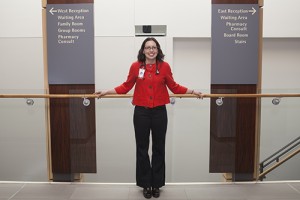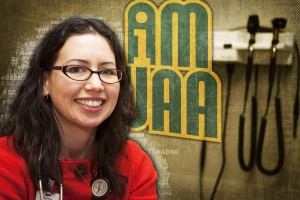Alumni Spotlight: Melissa Shein
by Tracy Kalytiak |
B.S. Biological Sciences '03, Alaska WWAMI E'03 Family Medicine Physician, Southcentral Foundation Anchorage Native Primary Care Center Hometown: Anchorage, Alaska Fun Fact: Melissa is training for her first half marathon.
Melissa Shein no longer remembers the name of the science class she wanted to take back in 10th grade, but she does remember West High staffers canceled it and enrolled her in a class she emphatically didn't want.
"They placed me in chemistry," she said. "It always sounded really intimidating so I never signed up for it. I hadn't had any exposure to it. I said 'I'm not supposed to be in this class! Get me out of here, this is chemistry!'"
The chemistry teacher, however, said she had to stay.
"I thought I'd give it a few days, talk to a counselor," said Melissa, an Inupiaq from Anchorage whose maternal grandmother was from Point Hope. "The first few days, I'm understanding it so far, it's making sense. I accidentally became very intrigued with chemistry, that there was this challenging information to learn and I could master it. I liked that it could explain life and nature and people. My confidence was raised and I thought, 'Wow, I can actually do this!'"
Melissa has since cultivated a more-than-formidable academic résumé, developing knowledge spanning the fields of engineering, biology, chemistry and medicine.
She studied engineering through the UAA Alaska Native Science and Engineering Program's Summer Bridge before delving into chemistry and biology at UAA and graduating with a degree in biological sciences. She then enrolled in Alaska WWAMI, a branch of the University of Washington School of Medicine that makes it possible for Alaskans to study medicine here at home.
Now, Melissa is a physician practicing family medicine at the Southcentral Foundation Anchorage Native Primary Care Center. She and another WWAMI-trained physician, Nora Nagaruk, will deliver keynote speeches Saturday, March 22, for the Alaska PreMed Summit at Rasmuson Hall and the Health Sciences Building, both on the UAA campus.
Nurturing discipline
Melissa says her teacher from that long-ago high-school chemistry course helped her stay on the path she wanted to take, toward the goal of being a doctor.
"She really encouraged me to take challenging classes," Melissa said. "I remember telling her I wanted to try to be a doctor because I liked science and health and she told me very simply and firmly, 'You will.' That really stuck with me, and I respected her so much I believed her!"
A boy who grew up to marry Melissa also encouraged her as she worked toward her goal. She and Dimitri Shein met in 10th grade; they now have a 7-year-old son and a 19-month-old daughter.
"From high school through medical school we studied together, every day," she said of her husband, who is now a certified public accountant. "It helped to have someone who was fun to be around, but not distracting from my studies, and who always encouraged me to keep studying hard. We set goals together and consistently worked toward them, together."
Her first goal after high school was getting a solid education that would move her closer to a successful medical school career. Herb Schroeder, director of UAA's Alaska Native Science and Engineering Program (ANSEP), reached out to Melissa when she was a senior in high school, in 1999. He encouraged her and other Alaska Native students at West to apply for the ANSEP Summer Bridge program.

Dr. Melissa Shein, a UAA and Alaska WWAMI alumna, now works in family medicine at
Southcentral Foundation Anchorage Native Primary Care Center.
Photo by Philip Hall/University of Alaska Anchorage
"I figured it wouldn't hurt to try something different, even though it wasn't medicine related," she said. " I am so glad I did. Although I ended up not pursuing engineering, I stayed connected to ANSEP, as I was drawn to the community and positive environment it created. It was really beneficial to have peers who were driven to be successful Alaska Native professionals to study with and maintain ambition for academic success.
"The internship experience during the ANSEP Summer Bridge program was a really neat way to bridge this transition from high school student to pre-professional," Melissa continued. "You learn about professionalism, self-discipline and develop [a] work ethic, in addition to the experience from the job duties. These were all very important qualities to cultivate the maturity required to go be successful in medical school and beyond."
As Melissa grew to know Schroeder, she saw how much effort he put into promoting her success and the success of other Alaska Native students.
"That passion was inspiring in that it made me feel more motivated to succeed, and also to strive to maintain such a passion for my own career," she said. "It's much harder to give up when someone behind you not only tells you that you can succeed, but they believe it and hold you to it! He creates an atmosphere in ANSEP where one feels both confident in their success, and responsible for being a role model for other students."
Despite feeling at home and supported in ANSEP, Melissa still felt drawn toward a career in medicine and classes that would move her toward medical school. She enrolled in chemistry and biology courses at UAA.
"As I took more upper-level biology classes, I found I could merge my interest in health/biology/chemistry by majoring in biological sciences, with an emphasis in molecular and cell biology," Melissa said, "so that's what I did!"
Melissa is particularly proud of one project she accomplished in a UAA microbiology class.
"We had to choose a bacteria to isolate from the environment," she said. "We found out there exist these bioluminescent bacteria."
She and her lab partner learned the bacteria live in squid, so they bought a frozen squid from 10th and M Seafoods, went online to study the anatomy of a squid, dissected it and dabbed a sterilized inoculating loop into the squid's ink sac. Melissa then scraped the ink onto an agar nutrient in Petri dishes.
"Plate after plate, day after day, it looked like it was going to be a failure," she said. "Then we happened to take one of the plates into the cold room and there was one little colony that glowed, neon greenish. We were so excited! We wrote letters on the agar and took pictures in the dark of the glowing letters."
Early in college, Melissa began asking guidance counselors and professors about medical school, and learned about Alaska WWAMI.
Committed to medicine
Melissa graduated from UAA with a bachelor's degree in biological sciences in 2003. She then launched into Alaska WWAMI, which, she said, offered her the same type of encouragement ANSEP had.
"I felt like the UAA faculty were like family, in a sense, as I knew them from undergrad," she said. "It helped to have familiar supportive people around me during that challenging period."
Melissa had watched shows about true crime and initially became interested in forensics. She considered becoming a forensic pathologist, and did a summer internship working in a pathology lab in college.
"The following summer I worked in the hospital with patients," she said. "When I found how interesting it was to interact with the living, and realized the potential gratification a doctor might get from improving people's lives, I decided not to pursue pathology."
Once in medical school, Melissa was relieved to find the subject matter there was not necessarily harder to learn than what she had been learning in college.
"However, the volume of material was enormous," said Melissa. "I studied at home some, but found it helped to get out and study in coffee shops. That way, I didn't feel deprived of social interactions." Studying with someone else helped Melissa better understand complicated concepts.
"If I didn't understand something, it was beneficial to have someone to explain their interpretation to me," she said. "If someone else didn't understand something, I benefited from explaining my understanding of the subject with them, by reinforcing the concept to myself."
Melissa served a couple of internships at the Alaska Native Medical Center in Anchorage while an undergraduate and volunteered there and at Planned Parenthood. She also participated in a Minorities in Medicine summer enrichment program as a pre-med student.
After receiving her University of Washington medical degree through WWAMI in 2007, Melissa served a residency at Providence Family Medicine until 2010, when she started working as a family medicine physician at Southcentral Foundation Anchorage Native Primary Care Center.
"I think the whole journey has been a fascinating, though sometimes grueling, way to develop and discover my strengths and weaknesses," she said. "I think my goals and priorities have really shifted as a result of seeing and experiencing so many positive and negative aspects of the human life cycle that the medical field allows you to see. I am grateful WWAMI allowed me to remain connected to Alaska, and the Alaska Native community, both during my education, and as a physician now."
 "Alumni Spotlight: Melissa Shein" is licensed under a Creative Commons Attribution-NonCommercial 4.0 International License.
"Alumni Spotlight: Melissa Shein" is licensed under a Creative Commons Attribution-NonCommercial 4.0 International License.















